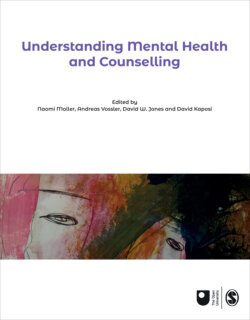Читать книгу Understanding Mental Health and Counselling - Группа авторов - Страница 17
References
ОглавлениеAudit Commission (1986) Making a reality of aommunity care. London: Audit Commission for Local Authorities in England and Wales, HMSO.
Boime, A. (1991) ‘Portraying monomaniacs to service the alienist's monomania: Géricault and Georget’, Oxford Art Journal, 14(1), pp. 79–91.
Breggin, P.R. (1993) ‘Psychiatry’s role in the holocaust’, International Journal of Risk and Safety in Medicine, 4(2), pp. 133–148.
Brown, G.W. and Wing. J.K. (1962) ‘A comparative clinical and social survey of three mental hospitals’, The Sociological Review: Monograph, 5, pp. 145–171.
Brundage, A. (2002) The English Poor Laws 1700–1930. Basingstoke: Palgrave.
Burton, R. (1638) The anatomy of melancholia: what it is with all kinds of causes, symptoms, prognostics and several cures of it. In three maine partitions with their several sections, members, and subsections. Philosophically, medicinally, historically, opened and cut up. Oxford: Henry Cripps.
Busfield, J. (1994) ‘The female malady? Men, women and madness in nineteenth century Britain’, Sociology, 28(1), pp. 259–277.
Bynum, W.F. (1974) ‘Rationales for therapy in British psychiatry: 1780–1835’, Medical History, 18(4). pp. 317–344.
Chesler, P. (1972) Women and madness. New York: Avon Books.
Cheyne, G. (1733) The English malady. London: G. Strahan.
Defoe, D. (1729) Augusta Triumphans: or, the way to make London the most flourishing city in the universe. 2nd edn. London: Andrew Moreton.
Edginton, B. (1997) ‘Moral architecture: the influence of the York Retreat on asylum design’, Health & Place, 3(2), pp. 91–99.
Foucault, M. (1967) Madness and civilization: a history of insanity in the age of reason. Translated from the French by R. Howard. London: Tavistock Publications.
Gelder, M., Mayou, R. and Cowen, P. (2001) Shorter Oxford textbook of psychiatry. Oxford: Oxford University Press.
Goffman, E. (1961) Asylums. Harmondsworth: Penguin.
Goldstein, J. (1987) Console and classify: the French psychiatric profession in the nineteenth century. Cambridge: Cambridge University Press.
Jones, D.W. (2016) Disordered personalities and crime: an analysis of the history of moral insanity. Abingdon: Routledge.
Jones, D.W. (2017a) ‘Moral insanity and psychological disorder: the hybrid roots of psychiatry’, History of Psychiatry, 28(3), pp. 263–279.
Jones, D.W. (2017b) ‘Psychopathy and the media’, Oxford Research Encyclopedia: Criminology and Criminal Justice. New York: Oxford University Press.
Jones, K. (1972) A history of the mental health services. London: Routledge and Kegan Paul.
Laing, R.D. (1965) The divided self. Harmondsworth: Penguin.
MacDonald, M. (1981) Mystical bedlam: madness, anxiety, and healing in seventeenth-century England. Cambridge: Cambridge University Press.
Pinel, P. (1806) A Treatise on insanity: in which are contained the principles of a new and more practical nosology of maniacal disorders than has yet been offered to the public. Translated from the French by D.D. Davis. London: Caddell and Davies.
Porter, R. (2002) Madness: a brief history. Oxford: Oxford University Press.
Porter, R. (2004) Madmen: a social history of madhouses, mad-doctors and lunatics. Stroud: Tempus Publishing.
Rembis, M.A. (2011) Defining deviance: sex, science, and delinquent girls, 1890–1960. Urbana, Illinois: University of Illinois Press.
Rogers, A. and Pilgrim, D. (2014) A sociology of health and mental illness. 5th edn. Maidenhead: Open University Press/Mcgraw Hill.
Scheff, T. (1966) Being mentally ill: a sociological theory. London: Weidenfeld & Nicolson.
Scull, A. (1979a) Museums of madness: the social organization of insanity in nineteenth-century England. London: Allen Lane.
Scull, A. (1979b) ‘Moral treatment reconsidered: some sociological comments on an episode in the history of British psychiatry’, Psychological Medicine, 9(3), pp. 421–428.
Scull, A. (1996) ‘Asylums: utopias and realities’, in Tomlinson, D. and Carrier, J. (eds.) Asylum in the community. London: Routledge, pp 7–17.
Scull, A. (ed.) (1981) Madhouses, mad-doctors and madmen: the social history of psychiatry in the Victorian era. Philadelphia: University of Pennsylvania Press.
Showalter, E. (1985) The female malady: women, madness and English culture 1830–1980. London: Virago.
Stewart, J. (2012) ‘“The dangerous age of childhood”: child guidance and the “normal” child in Great Britain, 1920–1950’, Paedagogica Historica, 47, pp. 785–803.
Stone, L. (1969) ‘Literacy and education in England 1640–1900’, Past and Present, 42, pp. 69–139.
Szasz, T. (1970) The manufacture of madness: a comparative study of the inquisition and the mental health movement. New York: Harper and Row.
Tooth, G.C. and Brooke, E.M. (1961) ‘Trends in the mental health population and their effect on future planning’, Lancet, 1, pp. 710–713.
Tuke, S. (1813) A description of the York Retreat. Philadelphia: Isaac Peirce.
Ussher, J. (1991) Women’s madness: misogyny or mental illness?. London: Harverster Wheatsheaf.
Walker, N. (1968) Crime and insanity in England. Volume 1: The historical perspective. Edinburgh: Edinburgh University Press.
